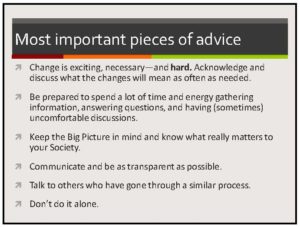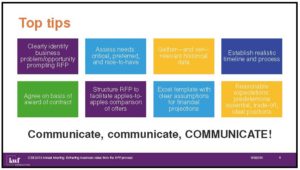MODERATOR:
Alison McGonagle-O’Connell
Collaborative Knowledge “Coko” Foundation
San Francisco, California
https://orcid.org/0000-0002-9032-3983
SPEAKERS:
Tom Beyer
Director of Platform Services
Sheridan PubFactory
Boston, Massachusetts
Dana Compton
Senior Consultant
KWF Consulting
Fairfax Station, Virginia
Amy McPherson
Director of Publications and Managing Editor
Botanical Society of America
Saint Louis, Missouri
REPORTER:
Alison McGonagle-O’Connell
At the 2018 CSE Annual Meeting, 3 RFP “experts,” each intimately familiar with different roles within the process, shared unique perspectives with one another, as well as with the audience of over 60 session attendees. The result was a lively discussion among presenters and a spirited Q&A following the presentation and discussion.

First, Amy McPherson, Director of Publications at the Botanical Society of America, shared her experiences issuing an RFP from the smaller society perspective. Small societies may issue RFPs for services including publishing or technology partnerships, peer review systems, or publishing platform services. These decisions may go through committees with members from many different backgrounds with differing ideas, and for this reason Amy highlighted the potential need for change management before beginning the process.
“Change is hard!” said McPherson. Without having all stakeholders on board, and in agreement with what the problem is, and why a particular solution is important, the RFP process with a multi-stakeholder committee may be very long and difficult. “Don’t go it alone,” said McPherson, who recommends engaging those with experience, including consultant organizations, to help keep the process moving forward.
Next, Dana Compton, Senior Consultant at KWF Consulting talked about the role of a consultant in the process. Her perspective extended to best practices for publishers of all shapes, whether issuing the RFP alone or with the help of a consultant. In her talk, Dana shared suggestions for eliciting impactful responses, whether from a commercial publisher, a technology service provider, or other vendor in workflow.

Dana highlighted the importance of being realistic when issuing an RFP. This included a suggestion to clearly identify the goals of the RFP early on in the process, and assess needs as “must-haves,” preferences, or “nice-to-haves.” Dana also made suggestions for structuring the RFP process to yield results focused on solving a specific, stated problem, and formatted to facilitate an apples-to-apples comparison of responses.
Above all, Dana stressed the importance of openly sharing accurate, reliable information with RFP respondents. “The promises made in a proposal are only as good as the data in the RFP,” she stated. Financial projections, proposed features, and service levels offered in proposals are all based on historical data and experiences.
Last, but certainly not least, Tom Beyer, Director of Platform Services at Sheridan PubFactory, presented from the perspective of a service provider that is responding to RFPs from publishers of all sizes, both with and without consultant involvement. Tom reported that most frequently, responses are to scholarly publishers directly, to the tune of 30–50 per year.
“The most important thing is to communicate!” said Beyer, stressing that if the 2 parties do work together, the relationship will be long term, and it is best to set both sides up for successful rapport right from the start with clear, frequent, open communication.
Throughout all the presentations, a common thread was transparency. The more transparent organizations can be with themselves about 1) what they really want to do in exploring any type of change, 2) what partners they realistically would most like to work with, 3) the resources they have available to make changes, and 4) what their timelines are, the more successful their RFP engagements can be. While some parts of the process historically require a black box approach, all presenters seemed to agree that more transparency and open communication guarantees all parties higher levels of success—whether that is finding the right partner, narrowing down respondents, or deciding as a vendor how much of one’s resources to put into a response.
Links to Presentations
